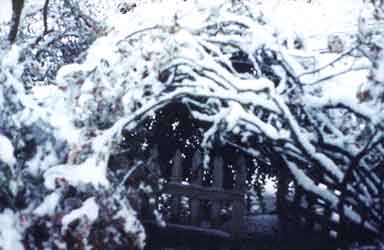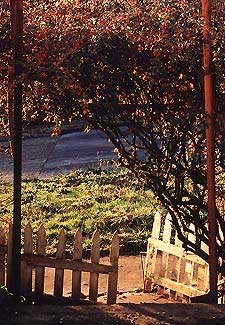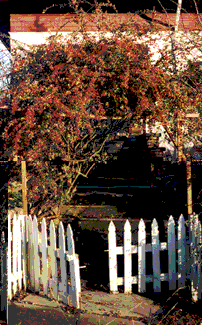 | |
"Thy seasons of grief, thy winters white with snowing, More lovely make thy face, adorn thy head, Add beauty to thy sweet eyes, ever glowing With love & strength & godhead; & thy tread Sweetens the earth; & all the gods are dead But thee,ăthee only, strowing Ever the land with youth." -from "To Demeter" | |
The Adventure of the Cotoneaster Arbor
For this shot I aimed the camera straight down a staircase into darkness. A rapid four inches of snowfall had succeeded at what past snowfalls had not, collapsing our cotoneaster arbor. The snow was heavier & wetter that day, & the Cotoneaster franchetii's naturally self-formed arbor mashed right down on the staircase, turning a pleasantly covered walk-down into a veritable rabbit-hole.
It's a very old shrub with lots of sturdy twisted trunks & many arching limbs. I've assumed it's Franchet's but maybe someday I'll find out otherwise, there are so many cotoneasters after all, though only a few that get this big. C. henryanus gets even bigger & some of the individual limbs on what I presume is Franchet's are rather longer than usual maximums. If measured from crown along the full curving sweep, the reach would exceed 18 feet. As Franchet is normally smaller than this, I've thought maybe this one's C. henryanus. But all the descriptions & pictures seem really close to Franchet, which has grey-green leaves, slightly furred & silvery underneath.
The grandparent shrub shown on this page has cast its berries around the yard over the decades, so there is a second Cotoneaster franchetii page discussing other specimens that have appeared on their own.
 The day it collapsed under snow, I might have become very upset, except that I thought it looked rather marvelous despite being a disaster. The main worry was that it looked like the cotoneaster had shifted its roots & crown, so might never pop up to its former height. When the snow melted, with no assistance the shrub raised itself about two-thirds of the way, which was better than I'd expected. Still, there was no longer any way around building an arbor structure over the staircase to restore a reasonable clearance.
The day it collapsed under snow, I might have become very upset, except that I thought it looked rather marvelous despite being a disaster. The main worry was that it looked like the cotoneaster had shifted its roots & crown, so might never pop up to its former height. When the snow melted, with no assistance the shrub raised itself about two-thirds of the way, which was better than I'd expected. Still, there was no longer any way around building an arbor structure over the staircase to restore a reasonable clearance.My excuse for waiting until it was an emergency is the fact that the shrub had joined its branches with a hawthorne on the opposite side of the staircase decades before we bought the place, & never been pushed down by snowfall in all that time. But then, no one else had ever weeded & fertilized & loosened up the soil around it, so we did increase the odds of this overhanging shrub shifting at the crown.
 The second photograph, a December portrait about one month after the collapse, shows the same shrub after I had gotten an arbor structure about two-thirds built. The third picture is the arbor as seen from the road, also taken mid-December.
The second photograph, a December portrait about one month after the collapse, shows the same shrub after I had gotten an arbor structure about two-thirds built. The third picture is the arbor as seen from the road, also taken mid-December.These portraits conveys the Franchet's semi-evergreen nature. Some of its leaves turn yellow & red in Autumn & fall off, resulting in an airiness showing more of the form of branches; but for the most part, the majority of the leaves stay green throughout winter. In Autumn the orange-red berries are very thick, & although they do shake off in the wind, even so, when thousands of berries were knocked free after this specimen was snow-crushed then got the shaking of its life when I braced it back up with considerable force & difficulty, it nevertheless had berries galore remaining, as the second two photos show.
Well, at this stage of restoring it after its collapse, creating a just-under-eight-foot height which is two feet higher than before, the practical function of the staircase was better than before the collapse. But I did feel a little bad because the cedar braces are a mite intrusive whereas formerly it needed no artificial assistance to be a completely natural arbor that only ever got a little in the way. But I am not yet finished with the arbor & have a "look" for it in mind I am pretty sure will work out, a rustic design inspired by a Japanese "rain-hat style" gate. When it's finished I'll revise this page. Come spring when the hawthorne tree (just out of the frame stage right, some of its bare branches visible in the third photograph hovering above the arbor) gets leaved, & the cotoneaster puts on new growth, most of the arbor structure will be hidden by the bushiness.